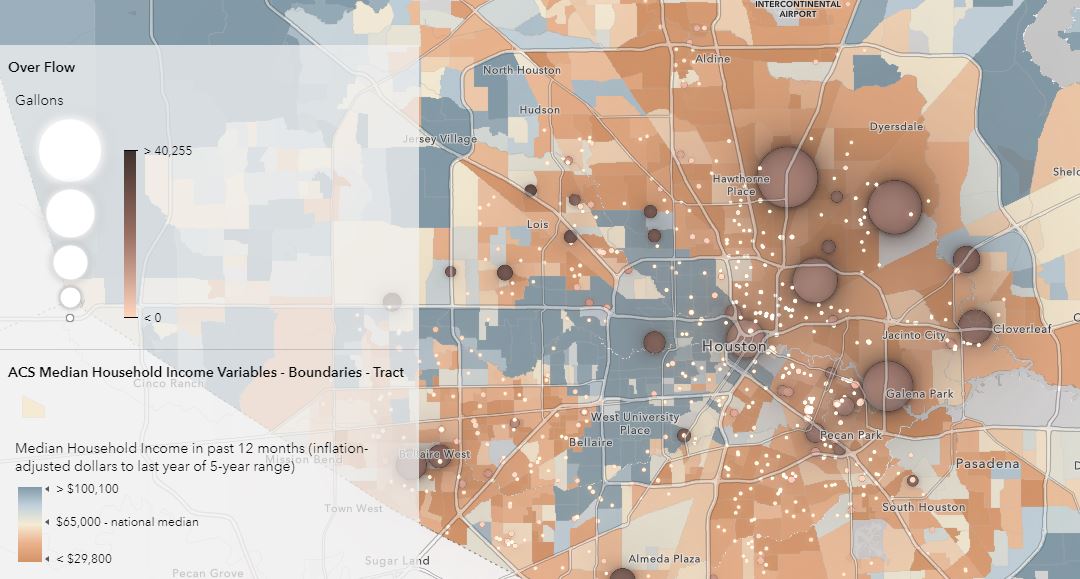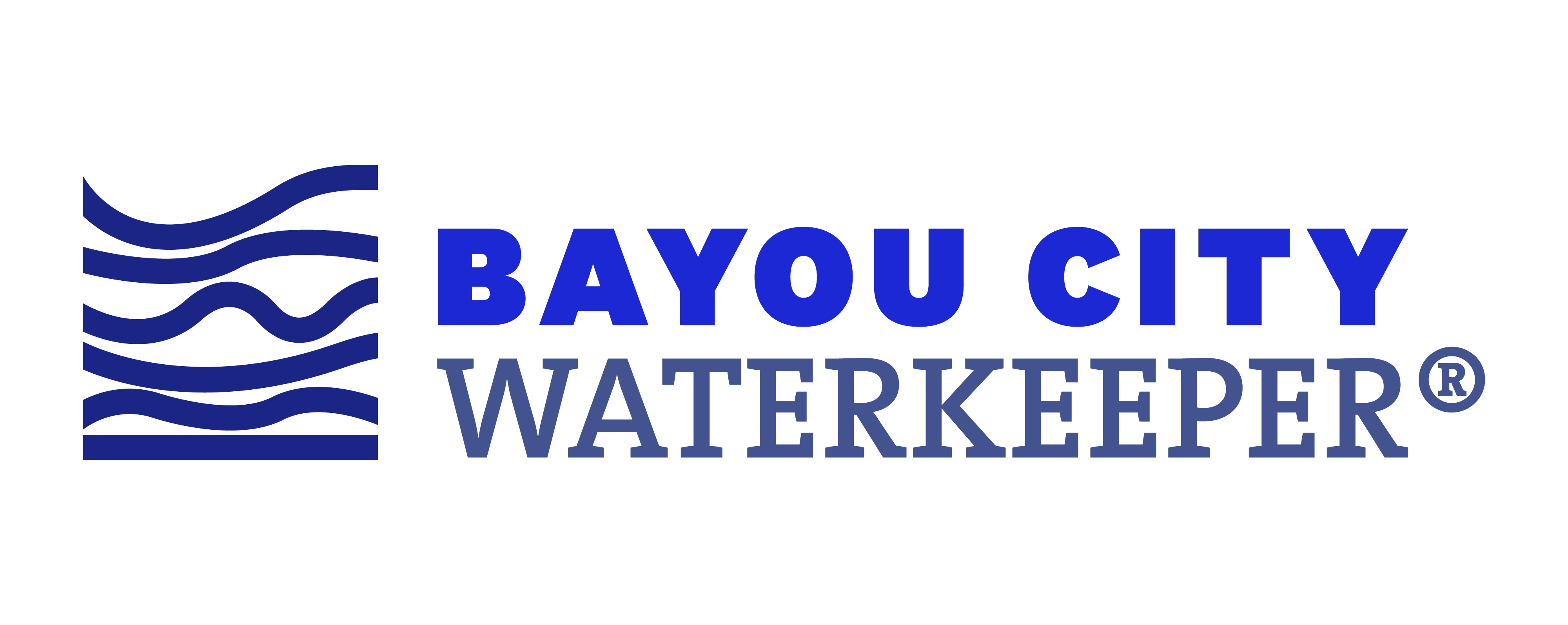For years, Bayou City Waterkeeper has worked to tackle a major source of water pollution in the Lower Galveston Bay watershed: the city of Houston’s sewage treatment system. Last year, these efforts culminated in a $2 billion consent decree which will lead to major infrastructure improvements across the city. This is a major victory, but our work continues: the settlement, which is far-reaching, may continue to leave Black, brown, and low-wealth communities behind.
Keep reading to learn more about these efforts, interact with our new tool to see how sewage pollution may affect your family and community, and visualize sewer injustices in our city.
Houston’s sewer injustices: A problem decades in the making
 Across the broader Houston region, wastewater treatment facilities reported more than 13,000 overflows from 2011 to 2017, representing more than 80 million gallons of sewage evading treatment. For a sense of scale, BP’s massive Deepwater Horizon explosion, the largest oil spill in U.S. waters, spewed 130 million gallons of oil into the Gulf of Mexico in 2010. The Exxon Valdez spill, the next largest, released 11 million gallons in Alaska’s Prince William Sound in 1989. The scale of our region’s sewage problem falls somewhere between these two disasters.
Across the broader Houston region, wastewater treatment facilities reported more than 13,000 overflows from 2011 to 2017, representing more than 80 million gallons of sewage evading treatment. For a sense of scale, BP’s massive Deepwater Horizon explosion, the largest oil spill in U.S. waters, spewed 130 million gallons of oil into the Gulf of Mexico in 2010. The Exxon Valdez spill, the next largest, released 11 million gallons in Alaska’s Prince William Sound in 1989. The scale of our region’s sewage problem falls somewhere between these two disasters.
Houston’s system has been responsible for a large portion of these overflows. For years, little was done to address them. After Bayou City Waterkeeper served a notice of intent to sue over how more than 9,000 of these overflows violated the Clean Water Act, the Environmental Protection Agency filed a federal enforcement action. In Spring 2021, a federal judge in Texas approved a legal settlement requiring the City of Houston to spend $2 billion on its sanitary sewer system over the next 15 years. As the City invests in major upgrades, we aim to help our community to see how this investment is (or is not) making a difference across Houston and closely monitor the city’s compliance with the consent decree.
Using the city’s data to visualize Houston’s sewer injustices
 In collaboration with Rice University’s Spatial Studies Lab, we’ve translated the city of Houston’s reports into an interactive map. This map looks at the data received so far from the city through its consent decree-mandated reports, alongside the U.S. Census Bureau data reflecting income and race or ethnicity. These visualizations reveal ongoing sewer overflows across the city, both from the city-owned system and problems on private property, for which the city has disclaimed any responsibility.
In collaboration with Rice University’s Spatial Studies Lab, we’ve translated the city of Houston’s reports into an interactive map. This map looks at the data received so far from the city through its consent decree-mandated reports, alongside the U.S. Census Bureau data reflecting income and race or ethnicity. These visualizations reveal ongoing sewer overflows across the city, both from the city-owned system and problems on private property, for which the city has disclaimed any responsibility.
Our analysis shows that sewer problems across the city continue to disproportionately expose Black, brown, and underinvested communities to unsafe sewage across the city, particularly because of problems associated with private sewer laterals. This is especially troubling because the city has disclaimed any financial responsibility for fixing sewer lateral problems, even when property owners lack resources to make repairs.
A closer look: How Houston’s sewage problems disproportionately burden communities of color
 The data continues to confirm Bayou City Waterkeeper’s previous analysis that communities of color and low-income Houstonians continue to be disproportionately impacted by system-wide failures. Residents in census tracts with higher than median income are not impacted in the same way as residents that live in census tracts outside the ‘Houston Arrow’. (Read more about the Arrow)
The data continues to confirm Bayou City Waterkeeper’s previous analysis that communities of color and low-income Houstonians continue to be disproportionately impacted by system-wide failures. Residents in census tracts with higher than median income are not impacted in the same way as residents that live in census tracts outside the ‘Houston Arrow’. (Read more about the Arrow)
In the image below, private sewer lateral overflow data, represented by black dots, is mapped against race and ethnicity data at the census tract level. This visualization shows that sewer lateral problems are concentrated in Hispanic/Latinx and Black communities, shown in red and blue, respectively.

The image below maps sanitary sewer overflows from 2021 against census tract data reflecting median household income. The blue-gray census tracts reflect areas where people with incomes above the median live in our city. The size of the circles reflects the volume of overflows. The larger the circle, the greater the volume of overflow in terms of gallons. This visualization shows that overflows occur at a higher volume in census tracts where the median household income is lower.

A continuing arc toward sewage justice
The consent decree represents an important first step to giving Houston residents a real solution to the sewage problems we see and smell after every major rain. This mapping shows that so far, it falls short in one key respect: it shortchanges our low-income neighbors who regularly deal with sewage backing up into their homes, pooling in the yards where their children play, and dirtying their backyard bayous and creeks. Over the 15-year life of the consent decree, Bayou City Waterkeeper will continue to push the city to close this gap and will closely monitor the city’s compliance with the consent decree. Along the way, we will share our progress and analysis with you. Together, we can work toward cleaner water and a healthier environment for all who call Houston home.
Bayou City Waterkeeper is a Houston-based organization focusing on water quality and wetlands protection across our region with an emphasis on climate resilience and environmental justice. After Bayou City Waterkeeper threatened to sue the City of Houston over more than 9,000 violations of the Clean Water Act associated with its sanitary sewer system in 2018, the U.S. Environmental Protection Agency initiated enforcement proceedings, which culminated in a consent decree requiring the city to invest $2 billion in its sanitary sewer system over the next fifteen years.
Thanks to former water justice fellow Mai Ton for their initial research on visualizing local sewer injustices.
